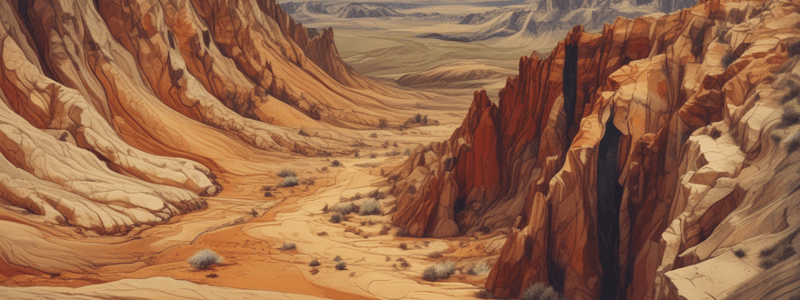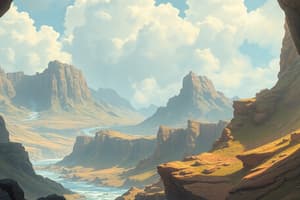Podcast
Questions and Answers
What percentage of all water on Earth is freshwater?
What percentage of all water on Earth is freshwater?
- 50%
- 3% (correct)
- 10%
- 1%
Where is most of the freshwater on Earth found?
Where is most of the freshwater on Earth found?
- Glaciers and ice caps (correct)
- Surface water
- Underground
- Oceans and seas
What percentage of all freshwater is found underground?
What percentage of all freshwater is found underground?
- 30% (correct)
- 40%
- 10%
- 20%
What is the term for the process by which water moves from the surface to the atmosphere and back again?
What is the term for the process by which water moves from the surface to the atmosphere and back again?
What is evaporation?
What is evaporation?
What factors increase evaporation rates?
What factors increase evaporation rates?
What is the term for the combination of evaporation and transpiration?
What is the term for the combination of evaporation and transpiration?
What is the process by which water is released from plants?
What is the process by which water is released from plants?
What is the final stage of the water cycle?
What is the final stage of the water cycle?
How much freshwater is available on Earth, in approximate gallons?
How much freshwater is available on Earth, in approximate gallons?
What is the primary function of water in the human body?
What is the primary function of water in the human body?
Where is most of the salty water on Earth found?
Where is most of the salty water on Earth found?
What percentage of the Earth's water is usable by humans?
What percentage of the Earth's water is usable by humans?
What is the role of stomata in plants during the water cycle?
What is the role of stomata in plants during the water cycle?
What happens to water when it changes state from a liquid to a gas?
What happens to water when it changes state from a liquid to a gas?
What is the result of the condensation of water in the atmosphere?
What is the result of the condensation of water in the atmosphere?
What is the term for the process by which water moves from the atmosphere to the surface of the Earth?
What is the term for the process by which water moves from the atmosphere to the surface of the Earth?
What is the relationship between the water cycle and the Earth's surface?
What is the relationship between the water cycle and the Earth's surface?
What is the primary way in which water is lost from plants during the water cycle?
What is the primary way in which water is lost from plants during the water cycle?
What is the result of the combination of evaporation and transpiration?
What is the result of the combination of evaporation and transpiration?
Flashcards are hidden until you start studying
Study Notes
Weathering
- Weathering is the process that breaks down rocks on the Earth's surface.
- There are two main types of weathering: mechanical and chemical weathering.
- Mechanical weathering breaks down rocks into smaller pieces through physical means.
- Examples of mechanical weathering include:
- Thermal expansion: temperature changes cause rocks to expand and contract.
- Frost weathering (ice wedging): water in rock cracks freezes and expands, making the crack bigger.
- Exfoliation: outer rock layers peel and break away as pressure above them lessens.
- Abrasion: rocks carried by wind, ice, water, and gravity hit and scrape against each other.
- Salt Crystal Growth: minerals left behind after water evaporation push into and through rock cracks.
Chemical Weathering
- Chemical weathering involves chemical processes that break down rocks.
- Types of chemical weathering include:
- Acidification
- Carbonation
- Hydrolysis
- Oxidation
- Living organisms
- Chemical weathering has two parts: decomposition of original materials and formation of secondary materials.
- Factors affecting chemical weathering rate include:
- Climate
- Environment
- Geological agents (water, oxygen, acids)
- Biological agents (roots, microbial organisms)
Soil
- Soil is a medium composed of sediment, minerals, organic matter, gases, liquids, and organisms.
- Soil components work together to provide an ecosystem for plant life.
- Soil takes a long time to form in barren regions.
- Soil develops through weathering, erosion, and deposition.
- Soil composition includes:
- Weathered sediments (sand, silt, clay, loam)
- Organic matter
- Minerals
- Gases
- Liquids
- Organisms
- Soil structure can be granular, platy, or columnar.
- Granular soil is preferred for growing fruits and vegetables.
Soil Erosion
- Soil erosion is the result of wind, water, or gravity moving soil from one place to another.
- Factors affecting soil erosion include:
- Exposure to the atmosphere
- Soil composition
- Climate
- Prevention methods include:
- Planting shelterbelts
- Preventing overgrazing
- No-till farming
- Planting cover crops
- Using mulch or soil matting
- Strip cropping
- Terracing
- Contour farming
- Crop rotation
Sediment Deposition and Mass Wasting
- Sediment deposition involves the transport of sediments downslope due to gravity.
- Mass wasting is the large movement of rock, soil, and debris downward due to gravity.
- Types of mass wasting include:
- Slumps
- Rockslides
- Debris flows
- Earthflows
- Creep
- Mudflows
- Causes of mass wasting include:
- Increased slope steepness
- Too much water
- Decreased vegetation
- Disruptive events (earthquakes)
Folds
- Folds are geological features caused by compressive stress to layers of rock.
- Types of folds include:
- Anticlines
- Synclines
- Monoclines
- Folds can be classified as:
- Asymmetric or symmetric
- Overturned or recumbent
- Isoclinal
- Chevron
- Parasitic
- Ptygmatic
- Disharmonic
Tectonic Plates and Faults
- The Earth's crust is made up of seven tectonic plates.
- Plate boundaries are where two tectonic plates meet.
- Faults are fractures in the rocks along a plate boundary.
- Types of faults include:
- Normal faults
- Reverse faults
- Strike-slip faults
- Stress types that cause faults include:
- Compressional stress
- Shear stress
- Tensional stress
Orogeny and Mountains
- Orogeny is the event of mountain formation.
- Types of mountains include:
- Fold mountains
- Dome mountains
- Hot spot mountains
- Mountain formation occurs due to tectonic plate collision and movement.
Water Cycle
- The water cycle is a natural process in which water journeys around the planet.
- The cycle includes:
- Evaporation
- Transpiration
- Condensation
- Precipitation
- Only 3% of the Earth's water is freshwater, and most of it is unusable by humans.
- Freshwater sources include:
- Glaciers and ice caps
- Underground water
- Surface water
Weathering
- Weathering is the process that breaks down rocks on the Earth's surface.
- There are two main types of weathering: mechanical and chemical weathering.
- Mechanical weathering breaks down rocks into smaller pieces through physical means.
- Examples of mechanical weathering include:
- Thermal expansion: temperature changes cause rocks to expand and contract.
- Frost weathering (ice wedging): water in rock cracks freezes and expands, making the crack bigger.
- Exfoliation: outer rock layers peel and break away as pressure above them lessens.
- Abrasion: rocks carried by wind, ice, water, and gravity hit and scrape against each other.
- Salt Crystal Growth: minerals left behind after water evaporation push into and through rock cracks.
Chemical Weathering
- Chemical weathering involves chemical processes that break down rocks.
- Types of chemical weathering include:
- Acidification
- Carbonation
- Hydrolysis
- Oxidation
- Living organisms
- Chemical weathering has two parts: decomposition of original materials and formation of secondary materials.
- Factors affecting chemical weathering rate include:
- Climate
- Environment
- Geological agents (water, oxygen, acids)
- Biological agents (roots, microbial organisms)
Soil
- Soil is a medium composed of sediment, minerals, organic matter, gases, liquids, and organisms.
- Soil components work together to provide an ecosystem for plant life.
- Soil takes a long time to form in barren regions.
- Soil develops through weathering, erosion, and deposition.
- Soil composition includes:
- Weathered sediments (sand, silt, clay, loam)
- Organic matter
- Minerals
- Gases
- Liquids
- Organisms
- Soil structure can be granular, platy, or columnar.
- Granular soil is preferred for growing fruits and vegetables.
Soil Erosion
- Soil erosion is the result of wind, water, or gravity moving soil from one place to another.
- Factors affecting soil erosion include:
- Exposure to the atmosphere
- Soil composition
- Climate
- Prevention methods include:
- Planting shelterbelts
- Preventing overgrazing
- No-till farming
- Planting cover crops
- Using mulch or soil matting
- Strip cropping
- Terracing
- Contour farming
- Crop rotation
Sediment Deposition and Mass Wasting
- Sediment deposition involves the transport of sediments downslope due to gravity.
- Mass wasting is the large movement of rock, soil, and debris downward due to gravity.
- Types of mass wasting include:
- Slumps
- Rockslides
- Debris flows
- Earthflows
- Creep
- Mudflows
- Causes of mass wasting include:
- Increased slope steepness
- Too much water
- Decreased vegetation
- Disruptive events (earthquakes)
Folds
- Folds are geological features caused by compressive stress to layers of rock.
- Types of folds include:
- Anticlines
- Synclines
- Monoclines
- Folds can be classified as:
- Asymmetric or symmetric
- Overturned or recumbent
- Isoclinal
- Chevron
- Parasitic
- Ptygmatic
- Disharmonic
Tectonic Plates and Faults
- The Earth's crust is made up of seven tectonic plates.
- Plate boundaries are where two tectonic plates meet.
- Faults are fractures in the rocks along a plate boundary.
- Types of faults include:
- Normal faults
- Reverse faults
- Strike-slip faults
- Stress types that cause faults include:
- Compressional stress
- Shear stress
- Tensional stress
Orogeny and Mountains
- Orogeny is the event of mountain formation.
- Types of mountains include:
- Fold mountains
- Dome mountains
- Hot spot mountains
- Mountain formation occurs due to tectonic plate collision and movement.
Water Cycle
- The water cycle is a natural process in which water journeys around the planet.
- The cycle includes:
- Evaporation
- Transpiration
- Condensation
- Precipitation
- Only 3% of the Earth's water is freshwater, and most of it is unusable by humans.
- Freshwater sources include:
- Glaciers and ice caps
- Underground water
- Surface water
Studying That Suits You
Use AI to generate personalized quizzes and flashcards to suit your learning preferences.




